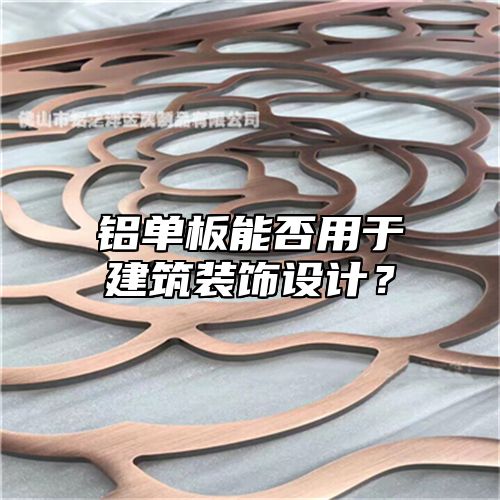

 Industry information
Industry information
Aluminum veneer is a lightweight, weather resistant, fire-resistant, and corrosion-resistant building material that has a wide range of applications in architectural decoration. Aluminum veneer can be used for architectural decoration design, but it needs to be selected and matched according to specific situations. This article will provide a detailed introduction from multiple aspects to answer this question.
We need to understand the basic characteristics of aluminum veneer. Aluminum veneer is formed by rolling aluminum alloy sheets and then sprayed on the surface. Due to its lightweight, weather resistant, fire-resistant, and corrosion-resistant properties, aluminum veneer has a wide range of applications in building decoration.
Let's take a look at whether aluminum veneer can be used for architectural decoration design:
1. Decorative effect: The decorative effect of aluminum veneer is one of the important factors to consider when it is applied in architectural decoration design. Generally speaking, the decorative effect of aluminum veneer is related to its color and shape. If aluminum veneer is needed as a decorative material on the exterior walls of buildings, it is necessary to choose light or dark colored aluminum veneer and adopt appropriate design methods to improve its decorative effect.
2. Installation stability: The installation stability of aluminum veneer is also one of the important factors to consider when it is applied in building decoration design. Generally speaking, the installation stability of aluminum veneer is related to its material quality and structural design. If aluminum veneer is needed as the main load-bearing structure in high-rise buildings, high-quality aluminum veneer should be selected and appropriate structural design should be adopted to improve its installation stability.
3. Waterproof performance: The waterproof performance of aluminum veneer is also one of the important factors to consider when it is applied in architectural decoration design. Generally speaking, the waterproof performance of aluminum veneer is related to its surface treatment method. If aluminum veneer needs to be used as decorative material in outdoor environments, it is necessary to choose aluminum veneer that has been anodized to enhance its waterproof performance.
4. Corrosion resistance: The corrosion resistance of aluminum veneer is also an important factor to consider when it is applied in architectural decoration design. Generally speaking, the corrosion resistance of aluminum veneer is related to its surface treatment method and material quality. If aluminum veneer needs to be used as decorative material in coastal areas or environments with high humidity, it is necessary to choose aluminum veneer that has undergone anodizing and anti-corrosion treatment to enhance its corrosion resistance.
Aluminum veneer can be used for architectural decoration design, but it needs to be selected and matched according to specific situations. By selecting appropriate colors and shapes, enhancing the installation stability of aluminum panels, and improving their waterproof and corrosion-resistant performance, it is possible to meet the needs of different architectural styles and usage environments, creating beautiful, practical, and stable building effects. When designing building decoration materials, it is necessary to choose suitable materials and design schemes according to specific situations to ensure the quality and stability of the overall decoration effect.